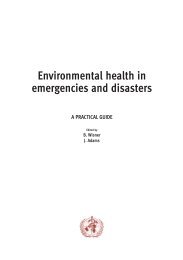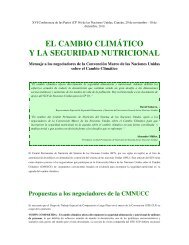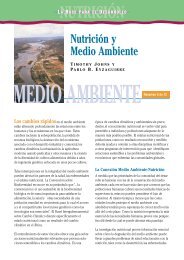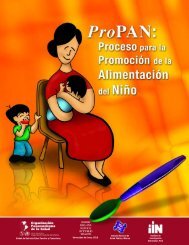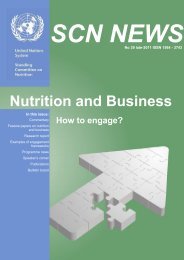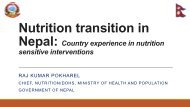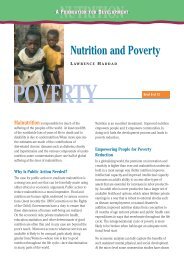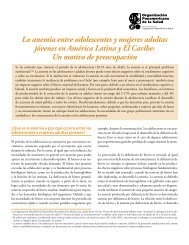SCN News No 36 - UNSCN
SCN News No 36 - UNSCN
SCN News No 36 - UNSCN
Create successful ePaper yourself
Turn your PDF publications into a flip-book with our unique Google optimized e-Paper software.
www.unsystem.org/scn FEATURES 49<br />
significant role in improving nutritional well-being – beyond their role in increasing overall food production.<br />
As the penultimate question, respondents were asked how they would spend an additional $50 million on nutrition<br />
in developing countries, and were permitted three priorities among 10 choices, plus the opportunity for<br />
write-in votes. When the first, second and third priorities were added together, maternal and child care and<br />
behavioral change communications received the most votes, 67.0% and 62.5%, respectively (Table 3).<br />
Finally, respondents were asked to score, on a 1-to-5 scale, specific organizations or groups of organizations<br />
on how well they have served the field of nutrition, relative to standards the respondents themselves would<br />
have set for them. When this same question was asked 10 years ago, the scores were those presented in<br />
Table 4. UNICEF was first, followed surprisingly by a then quite young organization, the Micronutrient Initiative.<br />
International NGOs and IFPRI were nearly tied in the third and fourth positions. At the bottom of this list:<br />
private foundations, two UN technical agencies and private consulting organizations.<br />
The scores in the current survey, with a couple of additional organizations added, are also presented in Table<br />
4, along with the change in score. UNICEF, although down a bit, again tops the list with an average score of<br />
3.78. And, once again, the Micronutrient Initiative has come in second, even closer to the top spot, with a<br />
score of 3.72. International NGOs and IFPRI retain their third and fourth slots. On the bottom of the list, we<br />
find the World Bank and GAIN and, once again, consulting firms and FAO, this time with the latter two switching<br />
positions, but with both registering higher scores than in the earlier survey.<br />
Concluding remarks<br />
Taken as a whole, the international nutrition community is optimistic about its mission and about its future,<br />
and is cognizant and appreciative of the research done in the past to elucidate the consequences of malnutrition<br />
and the relationships between nutrition and particular communicable diseases. But it believes that primary<br />
attention in the future needs to be given not to further refinement of these research findings on causality<br />
and consequences but rather to:<br />
• effective high-level advocacy, utilizing the powerful evidence already available,<br />
• generation of adequate resources to properly address malnutrition, and<br />
• improved management and implementation at scale of our programs, with particular attention to opportunities<br />
for community participation.<br />
And so let us return to Dr. Horwitz and to the remarkable optimism of those working in this field – an optimism<br />
that may be quite surprising to some of us, given what we as a community have experienced over the decades<br />
– but which probably would not have been so surprising to Dr. Horwitz. He would have pointed quickly<br />
to the increased understanding of the effect that malnutrition is having on mortality and on illness, and, in<br />
turn, its negative effect on national development. He would have noted the attention given to nutrition in the<br />
formulation of the Millennium Development Goals, the high premium placed on micronutrients by the Copenhagen<br />
Consensus, and the high profile identification of the importance of nutrition recently, for instance, in the<br />
statement of India’s Prime Minister on that country’s 60th Independence Day, and the placing of nutrition for<br />
the first time on the agenda of the most recent Economic Summit in Davos. Dr. Horwtiz would have enumerated<br />
for us the rapid increase in attractive and efficacious nutrition intervention opportunities that have<br />
emerged in recent years, from the proliferation of options to address micronutrient deficiencies in young children,<br />
to newborn vitamin A supplementation, to double fortified salt. He would have lauded the increasing<br />
attention now finally being directed to the long-recognized importance of the nutritional well-being of children<br />
under the age of two. We would guess, at the same time, that he would continue to lament the management<br />
and implementation shortfalls, which so often constrain the effectiveness of technically sound programs when<br />
they are taken to scale.<br />
Overall, however, we believe he would have been pleased with the community for having navigated at least<br />
some of the rapids, for having had to learn to swim upstream in the process, for having realized some notable<br />
successes, perhaps particularly in mobilizing communities, and also for having explicitly recognized the challenges<br />
that lay ahead.<br />
back to contents <strong>SCN</strong> NEWS # <strong>36</strong>




